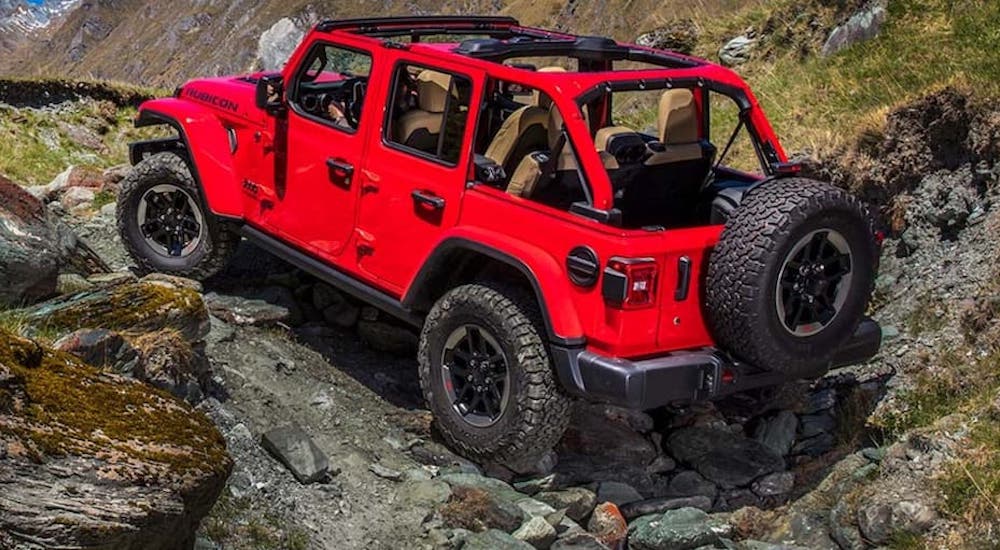Jeep is often placed at the top of the list when it comes to vehicles that perform off-road. The brand has long been known for manufacturing tough, adaptable models that are great in any terrain, making it the perfect choice for driving through snowy landscapes, rugged rock formations, or muddy trails. There are a variety of Jeep models to choose from, with some more capable of off-roading than others, but they all come with Jeep’s drive for technology and rugged reliability. If enjoying nature more is on your bucket list, get ready to learn why Jeeps are considered some of the best in the field and how to drive them in different conditions so you’re ready to hit the trails the minute you leave the Jeep dealer.
What Makes Jeep a Good Choice for Off-Roading Adventures?
Even after over 80 years in the industry, Jeep continues to perfect its 4×4 systems. This technology is the backbone of the brand’s off-road success and its ability to handle rough terrains. The 4×4 system differs depending on your Jeep model, but the following traits are just a few of the reasons why Jeep is a stand-out on the trails.
Off-Road Differentials
When off-roading in 4×4, it’s essential for the power to be sent to the wheels with the most traction. This is accomplished through mechanical, electronic, or brake-lock differentials that allow seamless transfer of power to the wheels and increased traction.

Front Sway Bar Disconnect System
The front sway bar connects the front wheels to prevent excessive body roll in corners. When this system is disengaged, the front wheels are disconnected, providing more articulation in the suspension system. In other words, the wheels can better remain in contact with uneven ground to improve traction and control. This system is found on the Wrangler Rubicon and the Grand Cherokee 4xe Trailhawk.
Skid Plates
What are skid plates? Think of them as the armor for the underside of your Jeep. They protect it from rocks that might get kicked up into the body while navigating rough terrain. Jeep’s skid plates are made from high-quality steel that has been engineered and tested to withstand the toughest hits.
Rock Rails
Jeep’s rock rails or rock sliders might look like they’re steps to help you get into the Jeep, but they’re much more than that. Like skid plates, they help protect the frame of your Jeep by deflecting rock and other objects away from the sides of the vehicle.
A Deeper Look at Jeep’s 4×4 Systems
Whether it’s the Quadra-Trac system for the Grand Cherokee or the Active Drive system found in the Renegade, you’re backed by a 4×4 system that provides some of the best innovations in the industry. However, Jeep’s most capable 4×4 systems are the Command-Trac and Rock-Trac options on the Wrangler and Gladiator.
Command-Trac
The Command-Trac system allows you to navigate through the toughest terrains easily. It has a “shift-on-the-fly” feature that lets you seamlessly switch in and out of 4×4 when driving under 55 mph. This is especially helpful when navigating from one driving surface to another or when the road conditions change quickly. When 4×4 is engaged, torque is split 50/50 between the front and rear axles to improve traction immediately. In addition, this system allows you to engage low-range, giving your Jeep more power at slower speeds. This makes tackling rock crawling, going up or down steep hills, and other off-road tasks easier.
Rock-Trac
This system is standard on the Rubicon trim of the Wrangler and Gladiator and provides increased control and torque for off-roading. It has the same “shift-on-the-fly” feature as the Command-Trac system. However, it has a heavy-duty transfer case with a 4:1 low range instead of a 2.72:1 low range. It also has Tru-Lok front and rear locking differentials to divide torque evenly between all four wheels.
Navigating the Off-Road Experience
Now that you know more about the 4×4 systems that Jeep offers, you might wonder how you use the technology to navigate safely through rough terrain. Many Jeep models have a Selec-Terrain system that lets you choose from different terrain modes, such as Sand/Mud, Snow, and Rock. Each mode changes the throttle response, transmission shift points, and traction control settings to make the vehicle work best in different off-road situations.
Tackling Snow and Ice
Winter weather can make driving dangerous, but Jeeps are made to handle these circumstances with ease. The traction control system senses when a wheel is slipping, applying the brakes on that wheel and sending power to the wheels that have better traction. This helps you maintain control and stability, even on wet or slippery surfaces. Even with the most capable 4×4 systems, it’s important to slow down in winter weather, especially in icy conditions, and turn gently rather than jerky the steering wheel too hard. This is because 4×4 only helps you put the power down––it doesn’t help you turn or stop any better.
Beating Muddy Terrain
Mudding is probably on your mind if you plan to enjoy off-road activities. Due to their strong drivetrains and specialized features, Jeeps are known for their ability to get through muddy terrain, but there are a few tips to keep in mind. When driving in mud, it’s important to keep moving forward. Engage the 4×4 system on your Jeep and choose the right gear. This mix gives you more torque and better control, so you can confidently drive through mud. Don’t speed up or slow down quickly because that can cause you to lose traction. Instead, keep your speed steady and under control to get through the muck and mud. Although Jeeps have sealed electrical systems and a high air intake, it’s still important to take your time and assess muddy areas, as they can trick you into thinking they aren’t as deep as they are.
Climbing to the Top
Rock crawling tests you and your vehicle’s abilities. Thankfully, Jeeps are built to go over rough terrain with their high ground clearance and strong frame, but there are still some things to consider. When rock climbing, it’s important to choose your line carefully and head for the path of least resistance. Having a spotter or using Jeep’s front-facing camera is always helpful to see where you are going. Engage the 4×4 system on your Jeep and use the low-range gearing to get the most power. If your Jeep has locking differentials, use them to ensure power goes to all four wheels equally, giving you the best traction.
Choose a Jeep for Your Next Adventure
There is a reason why certain Jeeps are Trail Rated. They have met strict requirements for traction, ground clearance, maneuverability, articulation, and water fording. The Trail Rated badge shows that a Jeep is ready for adventures off-road. A Jeep is a great choice if you’re planning to engage in outdoor adventure, especially if you want to join the off-roading fun. No matter the terrain, it can get you where you need to be. Once you understand the intricacies of the available 4×4 systems and how to navigate various situations, you’ll be ready to go on your first adventure. Stop by your local Jeep dealer to see what Jeep meets your needs and start enjoying the great outdoors.




